I’ve just posted a new tutorial on getting started with the ATtiny85 micro-controller. If you’re an Arduino Uno user its a fairly seamless transition to use this low-cost, embeddable chip:
Category: Arduino
-
ATtiny85 prototype board complete
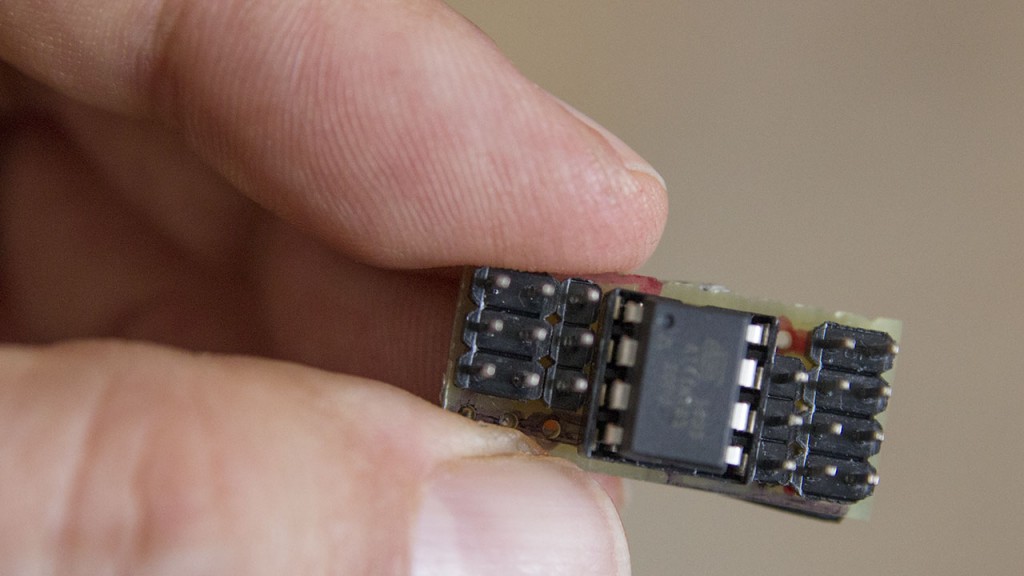
ATtiny85 breakout board model T-85 I Just finished scratch building and testing the first prototype of my ATtiny85 microcontroller board. Believe it or not this tiny thing is quite powerful. 1mHZ or 8mHz operation, 2.8v to 5.5v powering (everything from CS2032 watch batteries to AAAs, AAs, and LiPo battery packs). 5 input/output pins, PWM, analog input circuitry, In-System Programming with an Arduino motherboard.
My breakout board concept is to provide ground, power, and signal connections for each input so that sensors, leds, etc can be built with 3-pin 2.5mm female header connectors to plug-and-play with any of the inputs of the board. This also makes the standard input pin-compatible with servo motor 3-pin connections as well!
Now to crimp a few hundred 3-pin connections to try out various sensors and actuators…
-
ATtiny85 Processors Arrive!
I just received an order of 10 ATtiny85 microcontrollers from Jameco (they run about $1.75 each in small quantities) so I can begin to experiment with cloning Arduino code down to a much-less-expensive and easy to embed processor. So far it’s been a breeze, using an Arduino Uno as my programming device and getting the beloved blink sketch up and running in about half an hour.
Now back to designing the world’s smallest Attiny85 board…
-
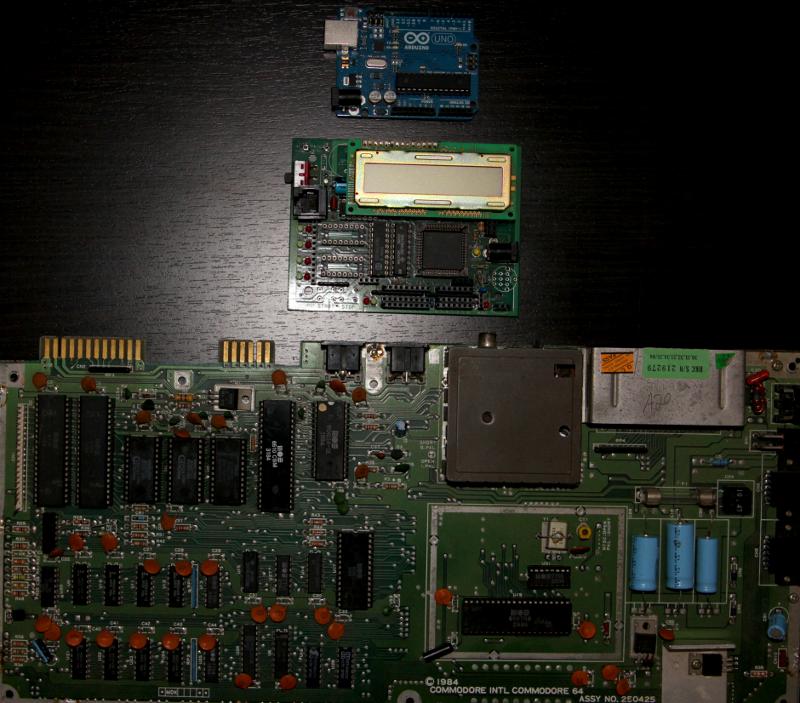
Moore’s law of 8-bit computers

Here’s a visual example of where 8-bit computers came from and where they are now:
On the bottom, a Commodore 64 home computer motherboard circa 1984, running at 1MHz. – original cost about $600.
In the middle, an MIT Handyboard robotics controller circa 1995, running at 2MHz. – original cost about $200.
At the top, an Arduino microcontroller circa 2010, running at 16MHz. – cost… about 30 bucks.
But only one of them can play Tower Toppler.
-
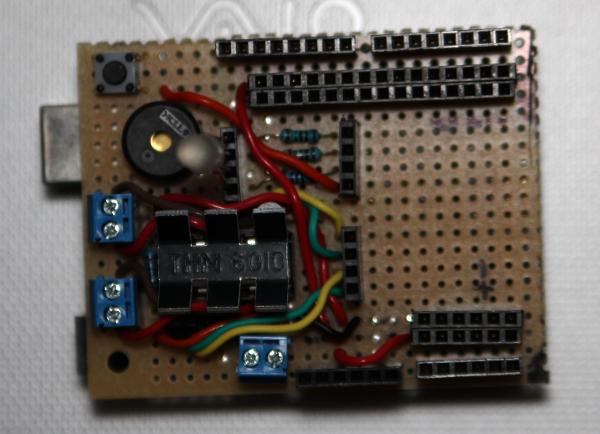
RoboShield Prototype part 2
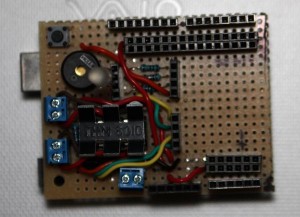
Here is the finished prototype of the RoboShield, a robotics daughter-board for the Arduino microcontroller. Here’s the tour:
- upper-left – reset button
- bottom-left – motor control h-bridge including 2 motor outputs and one motor power input
- left above motor controller – piezo buzzer, RGB LED, and current limiting resistors
- top-right – the Arudino’s 14 digital pins along with ground and 5v busses
- bottom-middle – the Arduino’s power header
- bottom-right – The Arduino’s analog inputs along with ground and 5v busses
- center running vertically – patch bays that allow assignment of the motor control, LED, and buzzer lines to any of the Arduino’s digital pins.
The empty space on the middle-right could be ued for servo motor connects. I’m still trying to decide if I need them.
Because all the component control lines on the board are routed to patch bay headers you have complete control of which Arudino pins you use for what. Also if you’re not using a component it doesn’t need to be taking up any pins
The ground and 5v busses spaced away from the input pins is an idea I borrowed from the MIT HandyBoard that was popular in hobby robtics several years ago (circa 1995). In many ways it was the progenitor of the Arduino
Here’s a page that explains how to connect various sensors to the Handyboard (and now the Robo-Shield as well).
-
Arduino Programming Notebook
Here’s the link to the Arduino Programming Notebook free PDF download, written by Brian W. Evans. It’s a handy reference to the Arduino programming language and even includes a few simple circuits with matching code in the back. You can also order a printed version for about $5.
-
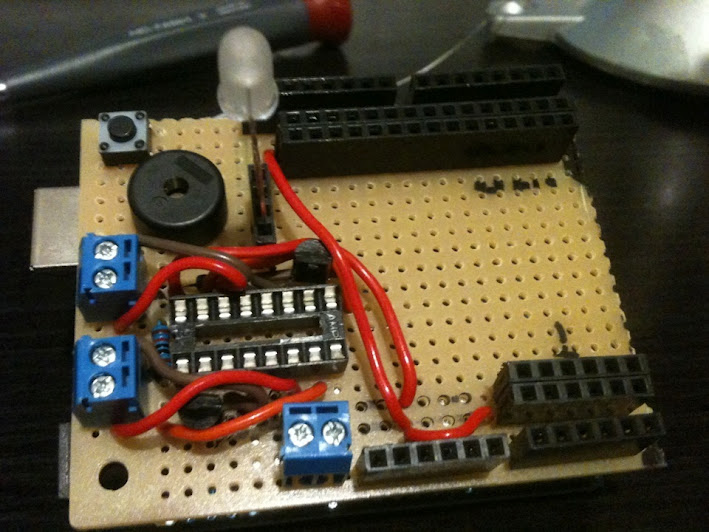
RoboShield Prototype part 1
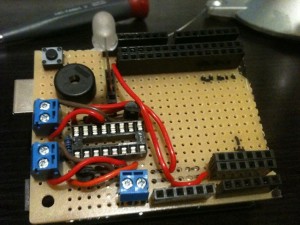
Here is the first set of components, connectors, and wire on the prototype RoboShield daughter-board for the Arudino microcontroller. The bottom-left quadrant of the board will be an h-bridge motor controller to drive two robot motors. Above that is a piezo buzzer and three-color RGB LED. The connector blocks on the uppper edge and the bottom right provide access to the Arduino’s input/output pins as well as ground and 5v buss lines to make interfacing sensors quick and easy. More on this soon…